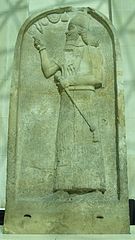
The Mosaic War Panel of Ur with shell, limestone, lapis lazuli, and bitumen created ca. 2600 found in the Royal Cemetery of Ur.
Series 1 Post 6
Ur, of Chaldea the Biblical birthplace of Abram (Abraham) does not provide any solutions in the problem of chronology. In fact by declaring Ur was of Chaldea the problem is magnified somewhat. The Chaldean people while ancient did not arrive in history until the first quarter of the first millennium BC. Their pre-first millennium origins are unknown with scholarship divided on where. Some prefer descent from the Aramareans earlier adversaries of Assyrian Middle Kingdom Kings the most famous being Tiglath-Pileser I c. 1115-1076 (Healy, 2000:5). Others claim Kassite, or Eastern Arabian origins (Stiebing Jr. 2003: 223).
Their language in their earliest history is not actually known either, as there is a mixture of Akkadian with some Aramaic place names surviving in their records (See Stiebing Jr. Citation, above). What is known of these people is they settled in the southern reaches of Mesopotamia that included the great ancient city of Ur. The Assyrian King Asher-nasir-pal II made the first mention of them in 878. His son Shalmaneser III, wages war on their tribes in defense of Babylon. After the decline of Assyria under Shalmaneser’s successors, the Chaldeans recovered to become a force for the later Assyrian King Tiglath-Pileser III to fight. Babylon became the prize between the two peoples until the Assyrian King Sennacherib sacked it, leaving it in ruins in 689.Despite the punishment of the Assyrians over the centuries, the Chaldeans persisted in their tribal settlements in the area, if not Babylon itself. Then in 626, Nabopolassar, of unknown heritage but considered to be Chaldean, seized theBabylon throne. Under the assaults of Nabopolassar, Assyria was weakening, when the Medes of Persia former vassals, under their leader Cyaxares they rebelled. Nabopolassar, and the Medes eventually joined by Scythians in 605 oversaw the complete defeat of Assyria with the son of Nabopoloassar, Nebuchadnezzar at the head of the Babylonia army. (Saggs, 2000: 153—164).

Modern humans and yes their helicopter on the top of the 3rd Dynasty of Ur built, Ur-Nammu Ziggurat with restored façade.
Ur itself reaches back in time to the Ubaid period (5,300—3800) of Mesopotamia, with its greatest period of history from archaeological findings as of this date. Ranging from 2,600- 2006, incorporating the Early Dynastic IIIA—to the end of the Third Dynasty of Ur. This is the period, which finds the Royal Tomb burials of Ur and the great ziggurat of King Ur-Nammu being built.
There could be much more to ancient Ur, but until archaeology actually provides it, we can only speculate. Therefore, the importance of Abraham coming from Ur of the Chaldeans is not a real blockbuster of information. It is more a point to date the redaction of this one verse from scripture at some time between 876—500BCE when there was a historical Chaldea or possibly later in memory of that time.
Works Cited
Akkermans, Peter M. M.G., and Glenn M. Schwartz. The Archaeology of Syria; From Complex Hunter- to Early Urban Societies (ca. 16,000–300 BC.) 3rd ed. Cambridge, Gt. Brit: Cambridge UP, 2005. Print.
Healy, Mark. The Ancient Assyrians. Oxford, Gt. Brit: Osprey, 2000. 5 Print.
Saggs, H.W.F. People of the Past; Babylonians. Berkeley, CA: U of California P, 2000. 153—164, Print.
Stiebing, William H. Jr. Ancient Near Eastern History and Culture. N.p.: Longman, 2003. 223 Print.
©Abram Back in Time 2000-2107. All Rights Reserved.

